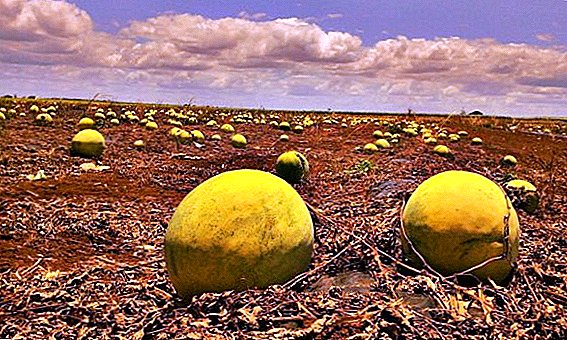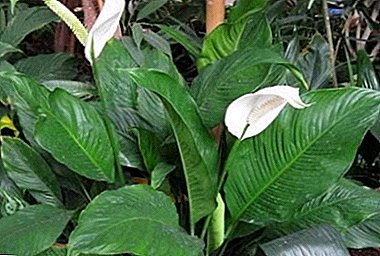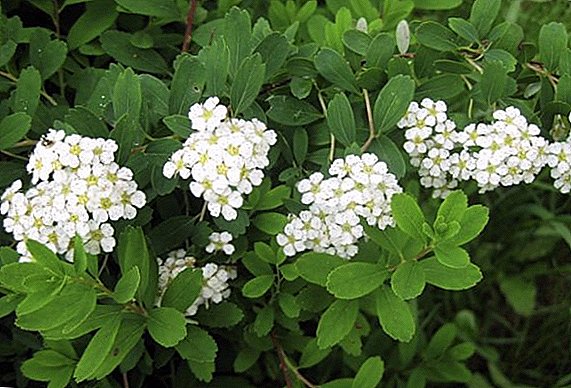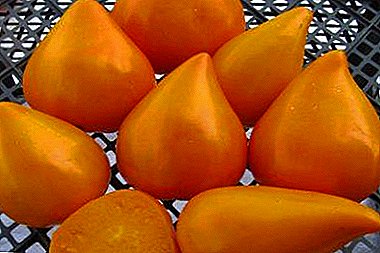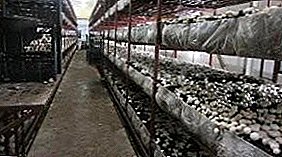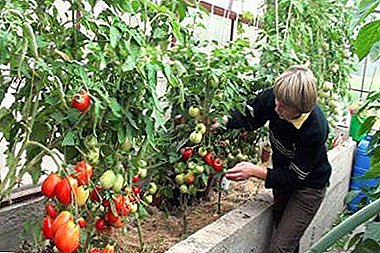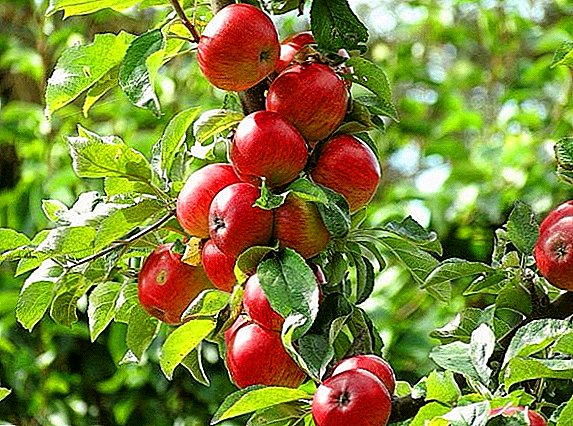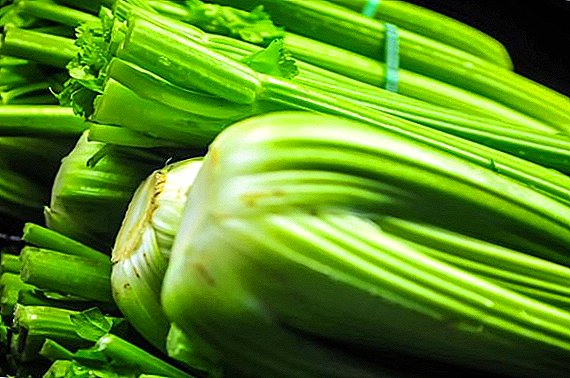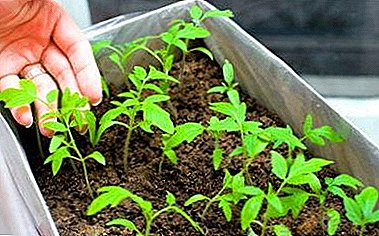
A gardener novice, who decided to grow tomato seedlings with his own hands, faces many difficulties.
One of the most important problems for many gardeners is to choose where to plant seeds and where to grow seedlings, especially since quite a lot of new, most incredible methods have recently appeared.
In this article, we will discuss the classic way of growing seedlings, from which the summer resident should start his way in the “seedling business” and we will answer the question - in which boxes is it better to plant tomatoes.
Description of the method of growing tomatoes
Sowing tomato seeds in boxes is considered one of the oldest methods.. Its essence is as follows: pre-prepared seeds are distributed at a certain distance over the surface of the soil, sprinkled with earth and tightened with a film to create greenhouse conditions.
After germination, the shelter is removed, and young plants are provided with systematic care.
Note. The greater the distance between the seeds, the longer young plants will be able to remain in the box without damage to their root system. But in any case, this method involves diving seedlings, which can be produced in individual containers or in the same container.
Like any method, the way of sowing seeds in boxes has its pros and cons. This method of growing tomatoes allows you to grow a large number of seedlings, but if you tighten with a pick, the seedlings in the middle rows will be left without enough light. Plants planted in one container are easier to take care of, but at the same time, if one seedling is sick, the threat of infecting the whole seedling is large enough.
A photo
See photos of tomato seedlings in boxes:





Little about capacity
Plastic or wooden boxes are commonly used for growing seedlings.. The first can be purchased at a specialty store, wooden ones can be made by oneself from plates or plywood. Pros and cons have each of these types.
Of course, a wooden box is an environmentally friendly container, but the porosity of its structure has a beneficial effect on the development and accumulation of pathogenic microorganisms on the walls.
Another plus of a box made of natural material is low cost, provided it is hand-made, but plastic containers are not expensive either. In addition, the plastic does not need careful treatment with fungicides, it is enough to clean it properly. Plastic container is easier to carry, it is stored longer.
When is the best fit?
In the boxes, you can grow seedlings of determinant, indeterminate varieties and different ripeness periods (early, middle, late), which can then be planted in greenhouses and in open ground.
Capacity Requirements
The optimal size of the boxes for planting tomatoes: width - 30 cm, length 50 cm, height - 8 - 10 cm, but these parameters are not critical, if only it were convenient for the gardener to move containers from place to place and place them on the windowsill. Another important condition: drainage holes must be made at the bottom of the boxthat will provide extra moisture.
Before sowing the container is usually disinfected: the plastic can be wiped with a tampon dipped in alcohol; wood - carefully treat with fungicides or copper sulfate solution (100 grams per 10 liters of water).
Seed preparation
Seed preparation can take place in several stages:
 Seed Testing for Germination. 30 - 40 grams of sodium chloride dissolved in 1 liter of water, immerse the seeds in the resulting solution for 10 minutes. Poor quality seeds will pop up, they must be collected and discarded; those that are "drowned" should be selected and rinsed with clean running water.
Seed Testing for Germination. 30 - 40 grams of sodium chloride dissolved in 1 liter of water, immerse the seeds in the resulting solution for 10 minutes. Poor quality seeds will pop up, they must be collected and discarded; those that are "drowned" should be selected and rinsed with clean running water.- Disinfection. Seeds for 20 - 30 minutes to immerse in a solution of potassium permanganate (1 gram per 100 ml of water), which merges after a time, and the seeds are thoroughly washed with water. Another option: seed material per day soaked in 0.5% soda solution (0.5 grams per 100 ml), or for 8 minutes in 2 - 3% solution of hydrogen peroxide, heated to + 40C.
- Treatment. For better germination, it is advisable to immerse the seeds in a growth stimulant nutrient solution (Appin, Zircon, Heteroauxin, etc.); method of breeding and duration of the procedure - according to the instructions. You can use the popular method: immerse the seed for 12 - 24 hours in a solution of aloe juice (1: 1) or honey water (1 tsp. Per glass of water), after keeping it in the refrigerator for 5 - 6 days.
- Soak or sprouting. Also, before sowing, seeds can be soaked for 12 hours in warm water (+ 25C), which must be changed every 4 hours. Another option: seeds germinate immediately, discarding all those that do not germinate. For this, the seeds are distributed over the surface of the moistened fabric laid out on a plate. The container is placed in a plastic bag and placed in a warm place (+ 23С - + 25С) for 3 - 5 days, during which the fabric needs regular moistening.
Soil preparation
Important. The ideal soil for growing tomato seedlings is loose, light, well drained, with an acidity level of 5.5 - 6.5 pH.
For growing seedlings, you can purchase ready-made potions in the store, to which experienced gardeners add simple garden soil (1: 1) and dolomite flour or chalk (1–2 tbsp per 10 l of substrate).
You can prepare the substrate yourself, using one of the recipes:
- mix 1 part of humus, sod land, sawdust, peat, add 2 tbsp to the mixture. wood ash, 1.5 st.l. superphosphate, 10 g of hydrated lime;
- garden soil, peat, humus are mixed in equal parts, a little ash and complex fertilizer are added to the mixture;
- turfy ground is mixed with peat, river sand, perlite, coconut fiber, wood ash in a ratio of 2: 1: 1: 1: 1: 0.5, respectively.
But in any case, the soil should be disinfected, since the spores of most infectious diseases are contained in it. Disinfection of the soil can be carried out thermally (roasting in the oven (+ 180С - + 200С) for 30 minutes or heating in a microwave for 1 - 2 minutes at a power of 850) or treated with fungicides according to the instructions. As an option: you can spill boiling water or bright pink solution of potassium permanganate.
How to sow seeds at home?
 At the bottom of the box, a layer of drainage with a thickness of 0.5-1 cm is filled up (expanded clay, small pebbles, eggshell, which will also provide additional food).
At the bottom of the box, a layer of drainage with a thickness of 0.5-1 cm is filled up (expanded clay, small pebbles, eggshell, which will also provide additional food).- Soil is filled into the container by 2/3 of the container volume.
- The soil is plentifully shed by settled (can be thawed) warm water.
- On the surface it is necessary to make grooves with a depth of 1 cm (for large-fruited varieties) or 0.5 cm (for small varieties), the distance between them is 3-4 cm. As an option: make holes with the same depth parameters in pencil, but in a staggered manner (distance between the pits - 3-4 cm).
- Seeds disintegrate along the grooves at a distance of 1 - 2 cm, sprinkled on top with soil, which is lightly crushed by hand, and moistened with a spray bottle.
- The container must be covered with glass, film or lid, then placed in a warm (+ 25C - + 30C) place.
- Systematically shelter should be removed for airing.
- After the appearance of the first shoots (after 7–10 days), the film can be removed, the capacity should be moved to the window sill, the temperature should be reduced to + 16С - + 18С.
Then you can watch a video on how to sow tomato seeds in a box:
Care for seedlings after planting
- Illumination. The recommended day length for seedlings should be at least 10 hours. Otherwise, it will have to finish illumination with phytolamp.
- Temperature conditions. The recommended daily temperature is +16 - + 20C, night - +13 - + 15C.
- Watering. The first watering is done with the appearance of the first shoots (1 cup of warm settled water per box (+ 22С), the second and subsequent waterings as needed: it is important not to allow drying, but excessive moisture can destroy still weak plants. The watering frequency should be proportional to temperature : the hotter, the more often watered.
- Fresh air. If possible, seedlings should be exposed to fresh air or slightly opened windows: this way the seedlings will “harden” and it will not be afraid of temperature drops in the open field.
- Top dressing. After 2 - 3 weeks after emergence of seedlings should begin to feed. It is better if it will be natural organic fertilizer based on compost, manure or grass; of the purchased ones, preference should be given to fertilizers based on humic acids and biohumus. The recommended frequency of fertilizer application is 1 time per week.
By sowing seeds and caring for seedlings according to these recommendations, in the summer you can get your first crop.


 Seed Testing for Germination. 30 - 40 grams of sodium chloride dissolved in 1 liter of water, immerse the seeds in the resulting solution for 10 minutes. Poor quality seeds will pop up, they must be collected and discarded; those that are "drowned" should be selected and rinsed with clean running water.
Seed Testing for Germination. 30 - 40 grams of sodium chloride dissolved in 1 liter of water, immerse the seeds in the resulting solution for 10 minutes. Poor quality seeds will pop up, they must be collected and discarded; those that are "drowned" should be selected and rinsed with clean running water. At the bottom of the box, a layer of drainage with a thickness of 0.5-1 cm is filled up (expanded clay, small pebbles, eggshell, which will also provide additional food).
At the bottom of the box, a layer of drainage with a thickness of 0.5-1 cm is filled up (expanded clay, small pebbles, eggshell, which will also provide additional food).